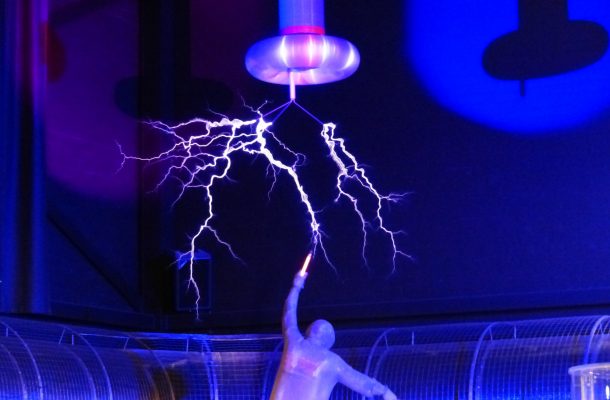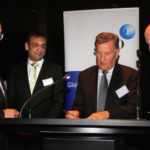Fifty years of physics

Every Friday of every July since 1968, the School of Physics at the University of Melbourne has hosted a public lecture in physics. This remarkable run of more than 200 lectures is a time capsule of just how far physics has brought us in half a century.
Here, Professor of Physics at the University of Melbourne, David Jamieson, the convenor of this year’s July Lectures, takes us through four of the biggest advances in physics over the last 50 years.
Quantum computing
“The strange theory of quantum mechanics has always held a fascination for our audiences,” says Professor Jamieson.
“Despite the tremendous success of the theory, many aspects remain difficult to understand.”
But exactly when are quantum effects important? In the 1971 July Lectures, when nuclear physicist Max Thompson asked this question, he could only guess at the impact quantum effects would have on our lives today and into the future.
In 1959, Richard Feynman first theorised that quantum effects could be used in computing, but it was not until the 2000s that very simple quantum processors started emerging.
“In the 21st century, the rise of quantum computing offers the promise of new machines that exploit the fundamental laws of quantum mechanics for revolutionary capabilities – performing tasks difficult or impossible by classical machines,” says Professor Jamieson.
“The strange laws of quantum mechanics has been a long-running theme of the July Lectures in Physics.”
Quantum computing is still in its infancy, but the question now is not ‘if’ but ‘when’ commercial quantum computers will become available. And when they do, they will be able to start crunching through some of the most challenging problems that are still beyond the ability of even the largest classical supercomputers.
General relativity
Ever since Albert Einstein proposed his general theory of relativity in 1915, which married the concept of space-time with gravity, people have been trying to work out ways to exploit this knowledge.
One of the outcomes of this theory – Professor Einstein predicted – was the existence of gravitational waves, and it famously took a century for science to catch up to Professor Einstein and finally prove their existence.
Early July Physics’ lecturers, like Geoff Opat, touched on this topic when discussing black holes, and then in 2003, Andrew Melatos presented his take on the theory of gravitational waves.
Professor Melatos made a return to the July Lectures lectern in 2016 to talk about the actual Nobel prize winning discovery of gravitational waves – a discovery that he was involved in as part of an international team.
Gravitational waves have opened a whole new way of navigating the mysteries of the Universe; but on Earth, our primary means of navigation also relies on general relativity.
“The remarkable technological spin-off from Einstein’s great theory of general relativity, put forward by him one hundred years earlier, is the world’s satellite-supported global positioning system,” says Professor Jamieson. “It operates on the same theory that proposed the existence of gravitational waves.”
The now-ubiquitous GPS was not yet in development when Graham Sargood asked Gravitation and Inertia: How are they related? in one of the 1968 July Lectures. Developed by the US Department of Defence and first launched in 1978, GPS is now a feature on billions of mobile phones.
Phones
And speaking of mobile phones, picture a telephone in 1968 and a telephone today.
When Anthony Klein gave a talk explaining what transistors were for at the 1973 July Lectures, Intel microprocessors contained 3,500 silicon transistors, each around 10 microns across (1/100th of a millimetre).
In 2018, the latest Qualcomm Snapdragon chips found in high-end mobile phones contain 3 billion transistors, each just 10 nanometres (1/100,000th of a millimetre) across.
Massive improvements in our understanding of light and electronics have led to phone cameras and touch screens, while efficient lithium ion batteries and wireless communication have combined to give us all access to the world in our hand.
“An extraordinary feature of the late twentieth and early twenty first century has been the revolution in technology accessible to everyone,” says Professor Jamieson.
“The rapid spread of mobile phones that can access the internet has been made possible by a long list of discoveries in the fundamental laws of physics. It’s impossible to do almost anything without leaving deep digital footprints in the server farms and databases of our financial, power, transport and mass media systems.
“In a random café anywhere in the world, a good number of the clientele will be employing a lot of physics – the band gap in silicon, Maxwell’s equations, the refractive index of silica, general relativity through GPS and other fundamental physics principles to surf the web, read a newspaper or keep in touch with friends and family.”
The Higgs Boson
At the University of Melbourne’s 1972 July physics talk, theoretical physicist Bruce McKellar asked the question Properties of matter: What is the inside story?.
This and another eight lectures over the next 40 years covered all the fundamental knowledge behind the Higgs Boson – the elusive sub-atomic particle that physicists at the time believed gave all matter its mass. But it took a massive piece of machinery, the Large Hadron Collider, to actually prove the existence of the Higgs Boson in 2012.
“The sensational breakthrough of the discovery of the Higgs Boson was presented in the 2012 July Lectures with keynote lectures that included the discoverers themselves and a lively panel discussion fielding questions from the audience,” says Professor Jamieson.
The next 50 years?
“If we look at the July Lectures in Physics we can expect lectures on some of the eagerly anticipated breakthroughs just beyond our reach for now,” says Professor Jamieson.
“These will surely include the discovery of dark matter, the first revolution triggered by large-scale quantum computing and the role of quantum mechanics in life.”
“There could also be breakthroughs in generating electricity from thermonuclear fusion, and the resolution of the most fundamental problem in physics: how to reconcile quantum mechanics and general relativity – two extremely successful but fundamentally incompatible theories”, he says.
“This will no doubt raise even more profound questions for the next 50 years.”
This article was published by Pursuit.
Daryl Holland has a PhD from the University of Bristol and spent 10 years researching algal blooms. He now edits the Science Matters channel of Pursuit, Melbourne University’s online research magazine. He has written for Crikey and ABC Online, and won the 2015 Ossie award for Investigative Journalism (Group).










